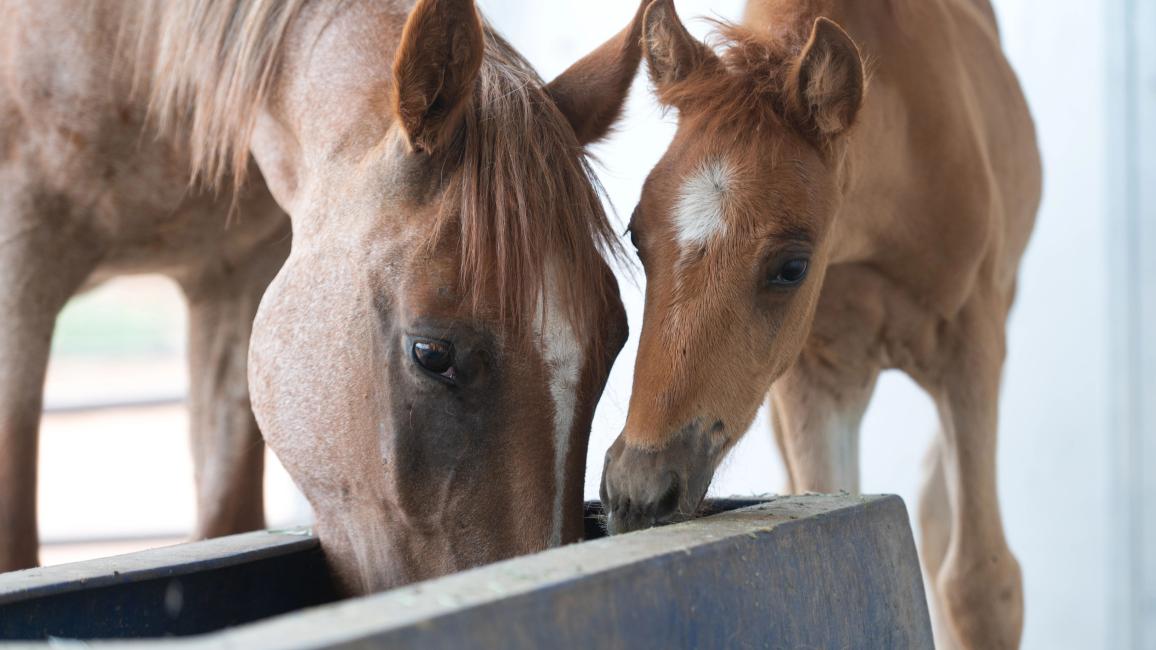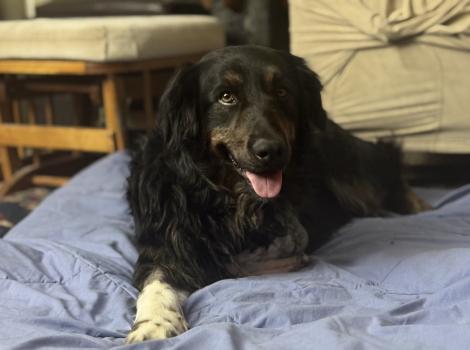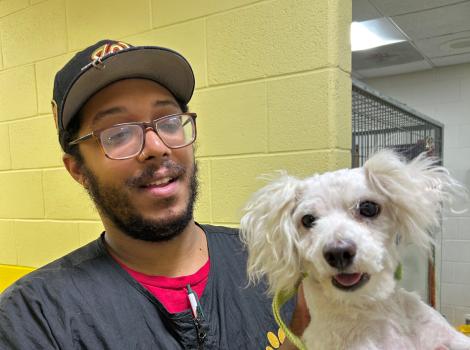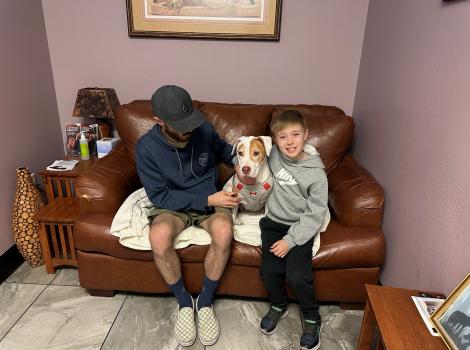14-hour rescue of a stranded mama horse and baby

A boater out to enjoy the day on Lake Powell, about 80 miles east of Best Friends Animal Sanctuary, was in for a surprise when they spotted a skinny horse on a sandy shore with a tiny foal tucked close to her side. With their ruddy coats, the pair blended in almost perfectly with the surrounding cliffside, but the isolated beach was definitely not where they belonged. They had no food and no way out, and they needed help. But getting the horses to safety would not be a simple task.
As soon as National Park Service officials heard about the marooned mare and her foal, they reached out to authorities on the Navajo Nation, which borders the lake. The mare had likely wandered onto the beach to give birth. But when the water started rising at around a foot per day due to spring runoff from heavy winter snows, she quickly became trapped on the nearly barren spit of land. Weak from lack of food, newborn in tow, and sheer cliffs all around, there was no way for them even to swim out.
[First frolicking foals born at Best Friends]
The Navajo Nation tried to find whom the horses belonged to, but no one came forward. Then, the group reached out for assistance from Kanab Veterinary Hospital and Best Friends Animal Sanctuary. The mare and foal could go to Best Friends, but getting them there wasn’t going to be an easy feat.
With the rescue team gathered and the National Park Service team delivering hay to the horses regularly until they could be rescued, planning began for how to extricate the equines.

Horse trailer, a boat, and hope
The first matter of business was figuring out transportation. With no access to the beach by land, it was not going to be as “simple” as driving up a trailer and coaxing the horses in. (And that would have been tricky anyway because neither horse was socialized with people, much less trailers.) The team had to find a boat, a trailer that could fit onto said boat, and a way to safely load the mare and foal into the trailer on the boat. Much easier said than done — especially that last part.
“It’s not something where you just head off,” explains Jen Reid, manager of Horse Haven at Best Friends. “It ended up taking about two weeks before we had the right boat and the right people. … I lost sleep at night thinking, ‘Oh my God, what are we going to do about this?’”
But finally, things started falling into place. The National Park Service had a boat with a drop-down deck that could work. And after measuring the available ship space and potential horse trailers, Horse Haven staff found one that would fit. Meanwhile, Jen and Dr. Breanna Isom from Kanab Veterinary Hospital had been discussing strategy and supplies.
When everyone felt ready, they gathered at 6 a.m. at Wahweap Marina on Lake Powell, loaded the trailer, and hit the water for the hour-and-a-half trip to the horses’ beach. In all, they had a team of eight from the National Park Service, Dr. Breanna and vet tech Lacy from Kanab Veterinary Hospital, and Jen and veterinary specialist Bonnie Palmer from the Sanctuary.

14-hour rescue effort
Plan A seemed straightforward. Using a tranquilizer dart to completely sedate mama, they’d lay her down on a sled and slide her right into the trailer with little fuss. “I built a sled!” Jen exclaims. “I built a whole sled for a horse, and I was really excited about my sled.
But, Jen jokes, they should have included mama in their group huddle beforehand because she was not in on the plan and did not play her part as expected. Even with two darts in her rear, every time she started getting sleepy and it looked like she might be about to give in to the tranquilizer, her little filly would nicker. And mama would come back with a jolt, unwilling to leave her baby without protection.
[Second chance for 33 neglected pasture pets]
Plan B was slightly more successful. Using ski safety fencing — which they had brought to block off potentially dangerous cliff edges from a sleepy, tranquilized horse — the team marched up the sand hill and slowly worked their way around the pair, trying to corral and guide them toward the boat and trailer. However, when they finally got her onto the boat’s ramp, there was no encouraging the mama any farther. Rather than enter the dark, enclosed trailer, she turned right back around and ran.
Back to the drawing board, the team looked at what they had available. They weren’t sure they’d be able to lift the trailer off the boat the same way they’d loaded it due to the added weight of the horses. So Plan A had originally involved transferring the horses into a second trailer parked closer to the isolated beach than the dock they’d left from. They’d already set up the trailer along with a corridor of pipe panels. But with the challenges they were having just getting mama and filly into the first trailer, trying to move her from one to another did not seem like the right idea anymore. And they could put those pipe panels to better use.

Successful rescue
After a trip to collect the panels, Plan C could begin. With the scorching July sun beating down on them (and a third tranquilizer dart in mama, as it had now been quite a while since the first two), the team carried the heavy, awkward panels up the sandy hill and once again began carefully closing in around the horses. “We just very slowly, meticulously finagled our way to where we had her enclosed in a pipe panel box with her baby,” Jen says. “And one foot at a time, we moved her and the baby in the panels. Lift, forward, down. Lift, forward, down. We were able to move her and keep her as calm as possible.”
When they reached the point where the mama had bolted in their previous attempt (right before the trailer), she tried again. This time, with a stronger barrier and all the resolve of a dozen people who’d been herding a pair of horses all day on a hot, sandy scrap of land, there was no charging through the line.
With one more gentle nudge, mama and baby entered the trailer, and the door was shut quickly behind them. Finally, after almost 14 hours, they were secure. And everyone could breathe a sigh of relief, get a much-needed gulp of water, and leave the lake behind them. They made the journey across the lake and then along the highway, shuttling the pair to the safety of Best Friends Animal Sanctuary.

Rest and recuperation
Since their harrowing adventure, mama and baby — now named Emma Dean and (appropriately) Marina — have been recuperating at the Sanctuary, safe and sound in a pasture of their own. “They’re doing well, eating, and putting on weight. We let them just settle in for the first week,” says Jen. “Now, I’ve started just being in there with them, trying a few things, trying to assess what we’ve got. Emma’s pretty smart and sensible. And a very good mama.”
With plenty of space, shade, and food — and fresh water limited to their trough instead of all around them — Emma and Marina have settled into their home-between-homes quite comfortably. Emma is relaxing enough to eat with Jen nearby, while Marina is growing more and more curious by the day. Once Marina is old enough to be weaned, the staff at Horse Haven will work on placing them both in new homes.
“The collaboration made it possible,” Jen says. “Everybody worked really, really well as a team throughout and with ideas — saying, ‘OK, that didn’t work; let’s brainstorm. How can we do this? How can we adjust?’ That’s what made this successful.”
This article was originally published in the May/June 2024 issue of Best Friends magazine. Want more good news? Become a member and get stories like this six times a year.







